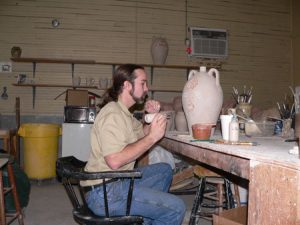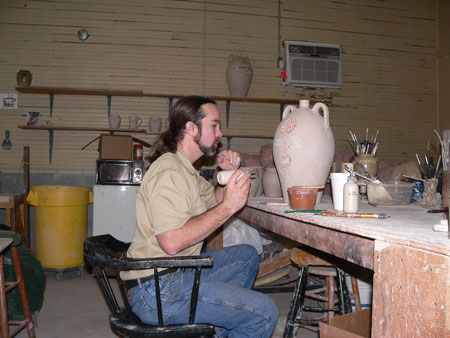
By Justin Guy –
About thirty thousand years! That’s how long humans have been working with clay and making it into objects we need or at least objects we believe we needed. For a generational equivalent that means that about 150 grandmothers ago your “mega” great-grandmother was just figuring out that she could take that sticky plastic earth from the river’s edge and mold it to her desired shape and with the help of fire turn it into something magical.
And I do mean magical by every sense of the word, because mega great grandma and mega great grandpa were not making bowls or cups or anything close to what today we would call “pottery.” No, that wouldn’t come for another 10,000-12,000 years later. Instead they were taking clay and remaking the world they saw around them. Molding the clay with hands and sharpened sticks they produced smaller versions of the things they wanted most. Deer and antelope were made to bring strength and opportunity to the hunt. More often the male and female human were produced in whole or in part to bring strength and opportunity to situations that humans would like to control most. If a small version of a deer could bring perceived luck to the hunt then perhaps a small version of a woman would bring luck to a marriage or perhaps assist in producing a child. These notions today might seem silly or even against religion but why did the primitive man or woman believe so strongly in the magic of clay? If we look at it one way, perhaps we can think of clay as a little magical, too.
The heat at the end of a match head can reach 1,500 degrees Fahrenheit with little trouble, so the heat of a campfire or even a bonfire has the potential to take clay down that irreversible path to permanency. Which, if you think about it, is still pretty magical. If you put wood in a fire, it goes away. If you put the bones of your meal or the bones of a fallen ancestor into a fire, they go away. But if you take this flesh of the earth, which you have molded into an object that you respect, the fire does not take it away, but serves to make it stronger.
It is easy to look down at the cave man and woman and how simple they were, but let us not make the mistake of thinking that we are so different. When we build our great churches and courthouses we use the strongest woods of the oak and the mahogany to reinforce the power these structures have in our lives. When we build our monuments we make them of the most durable rock that we can wield and when we propose the idea of eternity to a partner, we tend to put the hardest stone we can find, the diamond, as the centerpiece.
So, if we look around ourselves at the charm bracelets and lucky key chains. Or, if we take time to notice all the things that we hold dear and how we try to impress strength and power onto them, perhaps our mega great grandparents were not so wrong to think that clay was rather powerful and somewhat magical too.
Once again I would like to invite everyone to the March Pottery Stash located in Edgefield, South Carolina. If you wish to participate you are looking for a small clay medallion about two inches across that says “Pottery Stash, March 2013.” The first person to follow the clues to their conclusion and return the medallion to The Edgefield Advertiser, will be the proud owner of a humble but genuine piece of Old Edgefield Pottery. This contest is open to anyone of any age and does not require you to do anything dangerous or destructive to find the medallion. The clues are open to multiple interpretations and if the medallion is located inside you may have to access it during normal business hours. Good luck to all who seek to find.
This week’s clue is: Leave your knives behind you, there is no need for those. Have a drink while you stop to think, it’s right under your nose.

